Posted Sun, Nov 14, 2010 at 6:29 p.m. NOV 2010 Edition


|
Home |Expressions
|Impressions
|Hotpressions |News|
Greek Life |Education
|Entertainment
|Multimedia |Sports |
Food
|CulturalLife
|Features|
Archives
|
Top 5 ENTERTAINMENT 
Custom Search
|
|
“Book Review of Jerry Bridges' Transforming Grace: Living Confidently in God's Unfailing Love!”
Amy King Spector
Book Release Date:
April 22, 2008 Essentially, Bridges is trying to mediate, with Transforming Grace, the tensions between two common and polar options to Christian living: Is being a follower of Christ a matter of adhering to a checklist of dos and don’ts based on biblical principles? Or is it with the permission to “follow your heart” wherever that may lead—as long as it’s compatible with what your heart believes God should be? Bridges’ solution to settling the debate is to point out the inconsistencies and lack of logic both of these approaches contain. He identifies the behavior of checklist adherence “legalism” and the purely heart-following model “license,” and attacks legalism first in his argument with no mincing of words. He draws out the all-too-human pride of wanting to earn our salvation, or at least to do something to feel justified in “staying saved.” The term “performance treadmill” is a theme Bridges returns to again and again in the earlier parts of Transforming Grace. A particularly striking point appears at the start of Bridges’ book: He brings up the difference between a chapter 7 and a chapter 11 bankruptcy. In making a distinction between a chapter 7 bankruptcy, which is an utterly hopeless, irredeemable financial black hole, versus a chapter 11, which is a temporary bad spot that simply needs a little help for the moment, Bridges boldly challenges his readers to realize their honest belief about their own spiritual states. Immediately, this thoroughly appropriate and practical comparison introduces the heart of the gospel—that all men are spiritually in the state of chapter 7 bankruptcies. Sadly, Bridges continues with the analogy, a lot of Christians live a chapter 11 “reality” and thus shortchanges the absolute power and wonder of grace. After such a straightforward opening, Bridges slows down his pace to provide a more systematic explanation of the gospel, using the Scriptures to define what grace is, the tendency of human nature, God’s offer of salvation through grace, and what redemption—when we choose to accept it—looks like. For the most part, the earlier chapters of Transforming Grace are beautifully soothing, richly supported with biblical allusions. In later chapters, things get more complicated as Bridges also incorporates the significance of God’s law as stated in the Scriptures as outlines of how grace is practically carried out. The connections he makes between different Scriptural passages to prove his points are logical and reasonable. For example, Bridges breaks down a prescriptive understanding of the Ten Commandments by relating it to Leviticus 19:11-18 as well as 1 Corinthians 13, and it does make sense that these ten commands, as are all expressions of God’s moral laws, are “simply” descriptions of God’s character in action, encapsulated by grace. In establishing this point, Bridges shows how following God’s commandments is a necessary part of Christian living (and thus incompatible with license), but that this action is prompted by the freedom made possible by grace (and thus different from legalism.) What makes Bridge’s book a helpful contribution to the understanding of Christianity's core is its attempt to more fully integrate the roles that "faith" and "good works" should possess within a Christian's relationship with God. While various classics such as Dietrich Bonhoeffer's The Cost of Discipleship leans more towards a biblical justification for good works, and other classics such as Philip Yancey's What's So Amazing About Grace expounds upon the inextricable element of faith through grace, Bridges' Transforming Grace has a clear purpose of explaining how both elements -- obedience to God's commands (i.e. "good works") and utter reliance upon God's goodness and mercy (i.e. "grace") -- must absolutely be center and equal in a Christian's daily life. Still, despite Bridges’ earnestly thorough explanations, it is in the end a bit disappointing that he even attempts to address potential audiences favoring either legalism or license with as much respect as his book gives them. It’s almost as if he is afraid of being called a heretic or softie by the first group and still wants to prescribe a certain mold of Christianity to the second group with which he himself is comfortable. Hence, even as he lays out a lengthy chapter-by-chapter foundation of why grace is central to the Christian faith—as if to anticipate any objections to pure grace and also to prove his own correct theology, Bridges also lays out how Christians are to respond in the face of such awesome, transforming grace. As if to caution any overly unconventional receptions, as if there is still a checklist of appropriate behavior that would prove one is still the recipient of a relationship with God. This is not to say that this is in fact Bridges’ motive—to sneak in some performance-driven framework—in the ending chapters of his book. He does, after all, provide excellent explanations for why, in the context of grace, there are still better ways to lead a Christian life than a whatever-feels-good approach—as a matter of examining our own hearts and developing Christian character, which is unrelated with the sure salvation and freedom, made possible through grace, to commune with God. However, a less misleading and more direct way for how Bridges could have tackled this oft-misunderstood tension between works and grace might be to simply rise above the two rather immature and extreme perspectives of either legalism or license and pose a different question altogether. N.T. Wright’s After You Believe touches upon this issue a lot more deeply and directly precisely because it dismisses the two questions Bridges constantly refers to by stating immediately that Christian living is about a transformation of character. One would be able to understand the practical implication of such a mandate regarding either legalism or license without Bridges’ meticulous need for explaining about grace with such cautious attention towards potential misunderstandings in either direction. In short, the readability of Jerry Bridges’ Transforming Grace’s is hampered by an overly detailed framework of theology set so ahead and apart from the heart of Bridges' book that doctrine almost chokes out the simple miracle of God's grace's towards Man--the very point, tucked in the midst of all those careful words, of Transforming Grace. Nevertheless, the message of this book is a worthy attempt, a sincere if at-times overly intellectual opening to the dialogue and spiritual conversation that every Christian should be continuously engaged in with God and each other.
|
|
Copyright 2010 Pittsburgh Standard
Reproduction or reuse for profit prohibited without written consent from
Pittsburgh Standard

 Reading
Jerry Bridges’ Transforming Grace is akin to eating a
plateful of really thick pancakes, with moments between mouthfuls
that jolt one's palate just gratifyingly enough of sweet maple syrup
to encourage some more methodical chewing. That is to say, this is
not the most direct, simple, or even relevant explanation of how we
are to relate with God truly.
Reading
Jerry Bridges’ Transforming Grace is akin to eating a
plateful of really thick pancakes, with moments between mouthfuls
that jolt one's palate just gratifyingly enough of sweet maple syrup
to encourage some more methodical chewing. That is to say, this is
not the most direct, simple, or even relevant explanation of how we
are to relate with God truly.